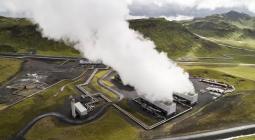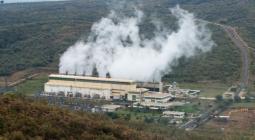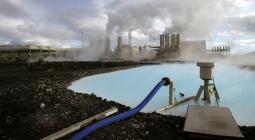East Africa's new love affair with geothermal energy
Until recently, there had been little interest in geothermal power in East Africa. But Kenya's trailblazing energy transformation policy is now inspiring others.
Kenya isn't exactly known for its bountiful thermal spas — but the East Africa nation has ambitious plans to expand geothermal energy sources for eco-friendly electricity.
The Great Rift Valley — a geological formation running 6,000 kilometers (3,729 miles) from Eritrea to Mozambique — offers bountiful opportunities: Not only is this area rich in geothermal activity underneath the earth's surface, the earth's crust is also particularly thin here, making exploration relatively easy.
The Olkaria Geothermal Power Station is a perfect example: the facility spans across roughly 200 square kilometers in the region; and since it first started operating in 1981, the plant has grown several times to exploit this clean energy source for Kenyans.
Today, Olkaria can deliver close to 900 megawatts — but that's nothing compared to the government's latest plans to produce close to 5,000 megawatts by the end of the of the decade.
And even that number represents only about half of Kenya's full geothermal potential.
A green future for Kenya — and beyond
Expanding the use of geothermal power plays a crucial role in Kenya's objective to produce exclusively environmentally friendly electricity by 2030.
Geothermal power is widely seen as a silver bullet for the long-term transformation of production that will help us meet our energy needs without fossil fuels. The International Renewable Energy Agency (IRENA) puts the so-called capacity factor for geothermal energy at over 80%; this refers to the value measurement of how reliably a power source can sustainably supply electricity over time.
In comparison, IRENA calculates less than 20% for solar energy.
"The countries with the greatest potential in this field are clearly Kenya and Ethiopia," says vulcanologist Jacques Varet, who has for decades consulted on geothermal issues in East Africa.
In contrast to Ethiopia, "Kenia has been investing in geothermal energy for a long time," he told DW.
Ethiopia also hopes to expand the use of geothermal plants in the future with some help from Kenya — Africa's leader in geothermal energy investment.
Ethiopia has one small geothermal energy facility, which has been operating since 1998.
Simple — but expensive
The physics behind the operation of geothermal plants are fairly straight-forward: geothermal steam, which is a mixture of water and minerals, shoots out of a artificial borehole in the ground and is diverted into a machine, which works like a turbine.
This turbine — hardly bigger than a car — is linked up to a generator, which then produces electricity.
The process involves hardly any carbon emissions, which is why geothermal energy is considered a source of green energy.
Research teams at Olkaria are testing several new boreholes with a view to expand the power plant.
Anna Mwangi, a geologist working at the majority government-owned utility company KenGen, explains the importance of fully testing the capacities of these boreholes before entering any further commitment:
"Sometimes we're lucky, and we'll complete a boring project for only about $4 million (€3.7 million). But if we run into subterranean issues, the exploration bill could be as high as seven or eight million dollars," she told DW.
There are currently 322 exploratory boreholes in Olkaria, each costing KenGen about $6 million to drill.
Adding to the costs are the high health and safety requirements, because the pressurized water found in these boreholes can reach temperatures of up to several hundred degrees centigrade.
Digging deeper — mostly into pockets
The specialized drilling equipment otherwise only used for exploring fossil fuel sources represents the biggest production expense in exploration.
"The main issues for exploring geothermal energy are: Does a government or a private corporation have the required capital to afford such a drilling rig? That's the only way to truly assess the full potential of a geothermal area. You simply have to drill," says Antony Karembu, a senior energy economist working for the African Development Bank Group, AfDB.
The cost of renting the machines has actually dropped in recent years as the rate of exploration of oil and other fossil fuels has plummeted amid a rise in the use of green energies.
These high costs are coupled with unknown risks, such as a low yield or changes in geothermal activity due to tectonic shifts, meaning newcomers to the geothermal game often are hesitant to invest their funds.
Geothermal intentions
The Kenyan government established the state-run Geothermal Development Company in 2008, which Karembu says serves as an insurance policy of sorts, with the government safeguarding all financial risks involved in exploration activities.
Geothermal energy enthusiasm since grown, with development partners like the AfDB being brought on board.
The African Union has even introduced a dedicated fund to cover the financial risks involved in geothermal exploration with non-governmental and private investors; one of the contributors to this fund is the German development bank, KfW.
"They (the AU) provide grants for private companies to commit to exploratory drilling," Karembu explains.
The 'great rift' in the geothermal game
It has become easier for East African countries to explore geothermal energy technologies of late, with Burundi, Rwanda, Zambia, Tanzania and Uganda all announcing plans to launch exploration projects.
However, Varet stresses that Kenya still leads the pack by a long stretch.
"Kenya's scientists have established really high standards over time with their engineers, vulcanologists and the like. There just aren't that many of those professionals in places like neighboring Ethiopia, despite the fact that the potential (of geothermal energy) there is huge," Varet said.
Ethiopia is hoping to start catching up, says Karembu: "A private exploration project called Tulu Moye has commissioned KenGen to conduct drilling in Ethiopia."
From Kenya into the world
Still, Kenya retaines the best accumulated know-how in Africa's geothermal industry, an asset it can sell not only to Ethiopia but use throughout the region, says Karembu.
Having worked for KenGen himself, Karembu says, "They [KenGen] have managed to really build up great internal expertise, which they have then made use of as consultant in places like the Comoros or Djibouti."
And by expanding to other parts of Africa, Kenya's experts are also bringing new insights back home.
Cover photo: Hot water exits from the pipe seen on the far right, which in the future will run the turbines for a new geothermal unit at Kenya's Olkaria V Power Station






